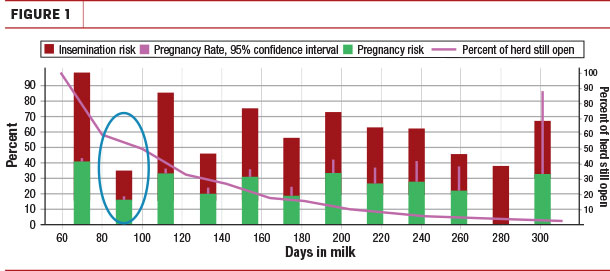At that time, the national average for PR was somewhere between 13-15% depending on what part of the U.S. you were in. A few years later, we had made great strides and increased the national average pregnancy rate to approximately 16-18%. If you wanted to find the really high performers, you could look to herds using Presynch-Ovsynch along with tail paint/chalk as a heat detection aid to achieve and even surpass the then-current PR goal of 20%.
Today, the paradigm has changed. We consistently see herds at a 30% PR and beyond. I recently averaged a group of 221 U.S. Holstein herds which we monitor on a monthly basis and found the average PR to be 25%, with the highest herd in the group having a PR of 45%. When we look at digging into reproduction, we need to break the PR into each of the 21-day intervals past the voluntary waiting period (VWP).
Uncovering an area of concern
Several of the popular breeding protocols give the dairy producer the opportunity to obtain numerous pregnancies either right at or shortly after the VWP. This can create an exceptionally high first 21-day pregnancy rate interval. This has helped establish many of the 30%-and-greater PRs we currently see in herds. However, when we break the PR into each 21-day interval, a lot of times we find an area of concern. This area of concern is the second 21-day interval. This is where I see many herds have an opportunity to increase the reproductive performance of their herd (Figure 1).

So why is the second 21-day interval important when we have so many animals getting pregnant at first service? Current research shows second-and-greater-lactation animals need to get pregnant early in lactation, and if we miss the opportunity on the second 21-day interval, days open, days in milk and calving interval on those animals will increase and lead to lower overall herd performance, both from a reproduction and production standpoint.
Also, the longer it takes to get these animals pregnant, the more likely they will be culled. With replacement cost being a major expense to producers today, we need to make sure we can keep older cows in the herd as long as possible. This affects not only the replacement cost, but it also affects overall milk production for the herd. The higher percentage of multiparous animals in the lactating herd, the higher overall milk production we achieve.
We have seen the effects of excessive culling on milk production in the past when cull prices were high. The results of this excessive culling saw many herds milking in excess of 47% first-lactation animals, causing overall herd milk production to decrease. Thus, anything we can do to ensure we can keep these multiparous cows healthy and pregnant and in the herd longer, the more profitable the dairy will be.
Factors affecting the second 21-day interval
As we investigate why the second 21-day interval falls short of what we would expect, we need to consider what factors are affecting this 21-day interval. There are several areas which affect reproduction in this interval and the sequential intervals. I will only address the three areas where most dairies fall short: heat detection, heat expression and non-cycling animals.
- Heat detection
As we see more and more first services turn to timed insemination, heat detection becomes less of a focus in many herds. When we lose focus on heat detection, it is hard to maintain the art of finding animals in heat, leading to lower reproductive performance. Actual heat detection is a combination of visual detection, use of heat detection aids, and the ability to interpret secondary signs of heat effectively and efficiently.
As we increase the reliance on timed insemination, we tend to lose the ability to implement heat detection. The goal of heat detection is not just to have a high heat detection rate, but to combine high heat detection with a high conception rate, which will result in a higher overall PR. If we fail to use heat detection as an effective tool, especially during the 21-day intervals after first service, we will have a loss of revenue due to extended calving intervals, lost milk production, an increase in veterinary costs and heifer-rearing costs, along with slower genetic progress.
- Heat expression
There is an abundance of factors that influence heat expression. One factor which is predominant during the second 21-day interval is milk production. Many of the animals which will be eligible to breed during this interval are also the animals which are reaching peak milk production. We know that as milk production increases, heat expression tends to decrease. Multiparous animals also express heat less than first-lactation animals, and there is usually a higher percentage of multiparous animals to inseminate in the second interval.
Overall cow comfort (flooring, bedding type, overcrowding, etc.) also influences heat expression, along with the seasonal and environmental impact on expression both during extreme hot and cold times of the year. Finally, the herd prevalence of lameness can further contribute to a high percentage of animals not expressing heat.
- Non-cycling animals
Non-cycling animals have always been an issue for a majority of dairies. At any time, 15% to 30% of lactating animals are not cycling. Many of these non-cycling animals tend to be early in milk production. There are several factors which influence animal cyclicity. One of the biggest issues is how animals handle the transition period. It seems like we cannot talk about reproduction without talking about the transition period. Despite efforts to improve this critical stage, I continue to see herds which failed to address the inadequacies of their transition period. Nutrition is the second area which we always review when looking at why we are having reproductive failures.
The second 21-day interval is also the same time when we see animals losing body condition because they are in a state of negative energy balance. When nutrition is not dialed in during early lactation, we can have many animals either in or approaching a negative energy balance and, consequently, stop cycling. Also, any stressful event which occurs during this breeding interval can cause animals to stop cycling or stay non-cycling. Lastly, we never know when animals actually start cycling. I like to say, “They don’t always read the book.” Those cows which begin cycling in the middle of the current synchronization protocol will not necessarily synchronize with the timed insemination and, therefore, not become pregnant to that service.
Even with todays’ high-performing reproduction, there are still areas where we can improve. Looking at your second 21-day breeding interval can sometimes reveal opportunities. Be sure to address heat detection, heat expression and non-cycling animals to improve or maintain excellent reproductive performance. ![]()

-
King Smith
- Western SRS Manager of Technical Services Programs
- Select Sires Inc.
- Email King Smith
Focus on these areas to minimize the down periods of the 21-day pregnancy rate
- Control the energy intake in far-off dry cows
- Provide adequate metabolic protein levels during the entire dry period
- Manage risk of hypocalcemia during close-up period
- Minimize stress, weight loss and pen moves
- Provide adequate and comfortable resting areas
- Remove stressors (overcrowding, mixed parities (first-lactation versus older))
- Provide access to adequate clean water
- Minimize long days dry
- Optimize days in the close-up pen






